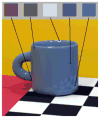Surface color perception and equivalent illumination models
- PMID: 21536727
- PMCID: PMC3249236
- DOI: 10.1167/11.5.1
Surface color perception and equivalent illumination models
Abstract
Vision provides information about the properties and identity of objects. The ease with which we perceive object properties belies the difficulty of the underlying information-processing task. In the case of object color, retinal information about object reflectance is confounded with information about the illumination as well as about the object's shape and pose. There is no obvious rule that allows transformation of the retinal image to a color representation that depends primarily on object surface reflectance. Under many circumstances, however, object color appearance is remarkably stable across scenes in which the object is viewed. Here, we review a line of experiments and theory that aim to understand how the visual system stabilizes object color appearance. Our emphasis is on models derived from explicit analysis of the computational problem of estimating the physical properties of illuminants and surfaces from the retinal image, and experiments that test these models. We argue that this approach has considerable promise for allowing generalization from simplified laboratory experiments to richer scenes that more closely approximate natural viewing. We discuss the relation between the work we review and other theoretical approaches available in the literature.
Figures








Similar articles
-
The Representation of Color across the Human Visual Cortex: Distinguishing Chromatic Signals Contributing to Object Form Versus Surface Color.Cereb Cortex. 2016 May;26(5):1997-2005. doi: 10.1093/cercor/bhv021. Epub 2015 Feb 12. Cereb Cortex. 2016. PMID: 25681421
-
Transparent layer constancy under changes in illumination color: Does task matter?Vision Res. 2015 Nov;116(Pt A):53-67. doi: 10.1016/j.visres.2015.09.003. Epub 2015 Oct 8. Vision Res. 2015. PMID: 26409045
-
Color appearance of real objects varying in material, hue, and shape.J Vis. 2010 Sep 30;10(9):10. doi: 10.1167/10.9.10. J Vis. 2010. PMID: 20884608
-
Color Perception: Objects, Constancy, and Categories.Annu Rev Vis Sci. 2018 Sep 15;4:475-499. doi: 10.1146/annurev-vision-091517-034231. Epub 2018 Jul 13. Annu Rev Vis Sci. 2018. PMID: 30004833 Review.
-
Methods for Assessing Quantity and Quality of Illumination.Annu Rev Vis Sci. 2019 Sep 15;5:479-502. doi: 10.1146/annurev-vision-091718-015018. Epub 2019 Jun 21. Annu Rev Vis Sci. 2019. PMID: 31226013 Review.
Cited by
-
Short-term memory affects color perception in context.PLoS One. 2014 Jan 27;9(1):e86488. doi: 10.1371/journal.pone.0086488. eCollection 2014. PLoS One. 2014. PMID: 24475131 Free PMC article.
-
Detection of changes in luminance distributions.J Vis. 2011 Nov 15;11(13):10.1167/11.13.14 14. doi: 10.1167/11.13.14. J Vis. 2011. PMID: 22085597 Free PMC article.
-
A Bayesian model of lightness perception that incorporates spatial variation in the illumination.J Vis. 2013 Jun 28;13(7):18. doi: 10.1167/13.7.18. J Vis. 2013. PMID: 23814073 Free PMC article.
-
Scaling depth from shadow offset.J Vis. 2021 Nov 1;21(12):15. doi: 10.1167/jov.21.12.15. J Vis. 2021. PMID: 34842901 Free PMC article.
-
The dynamic range of human lightness perception.Curr Biol. 2011 Nov 22;21(22):1931-6. doi: 10.1016/j.cub.2011.10.013. Epub 2011 Nov 10. Curr Biol. 2011. PMID: 22079116 Free PMC article.
References
-
- Arend LE, Reeves A. Simultaneous color constancy. Journal of the Optical Society of America A. 1986;3:1743–1751. - PubMed
-
- Barlow HB. Possible principles underlying the transformations of sensory messages. In: Rosenblith WA, editor. Sensory communication. M.I.T. Press and John Wiley & Sons, Inc; 1961. pp. 217–234.
-
- Beck J. Judgments of surface illumination and lightness. Journal of Experimental Psychology. 1961;61:368–373. - PubMed
-
- Beck J. Surface Color Perception. Ithaca: Cornell University Press; 1972.
-
- Bell DE, Raiffa H, Tversky A. Decision Making: Descriptive, Normative, and Prescriptive Interactions. Cambridge: Cambridge University Press; 1988.
Publication types
MeSH terms
Substances
Grants and funding
LinkOut - more resources
Full Text Sources
Other Literature Sources

